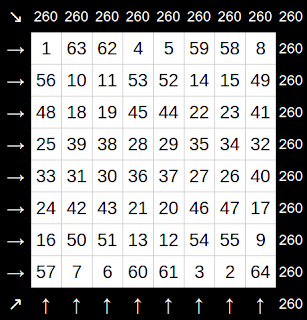On performing a trivial transform on the Wen pairs, we obtained a distribution of ten (initially nine*) groups of hexagrams with the following properties:
- The ten groups exist in five matched pairs
- The same quantity of hexagrams is present in both halves of a given pair of groups
- All hexagrams in any given group have the same yao-number
- Yao-numbers of paired groups complement to 360
- Summing yao-numbers over all 32 pairs of hexagrams produces 11,520
- 144/216 -- one member each
- 168/192 -- three members each
- 172/188 -- six members each
- 180/180 -- ten members each
- 176/184 -- twelve members each
In a separate discussion of hexagram arrangements, we observed that the xiantian arrangement (i.e. complementary opposites) over the ashtapada (i.e. 8x8 field) exhibits another kind of complementarity based on the number 65. Hexagrams may be interpreted as binary expressions of the counting numbers [1..64]. When arranged on the ashtapada according to xiantian, any pair of hexagrams separated by 180 degrees of rotation will sum to 65.
 |
| Xiantian magic square |
These two modes of complementarity appear quite different in character. The former is based on a simple transformation of a peculiar pairing relationship attributed to King Wen of Chinese antiquity. The latter mode arises in large part from a distinct spatial arrangement of the same 64 elements interpreted as numbers. Neither mode seems especially well-related to the other, yet both coexist in the same set of 64 hexagrams and express two different forms of complementarity. It must be granted 1) that both modes are based on 'pairing,' but the pairings (xiantian vs. Wen) are fairly discrete; and 2) that complementarity figures prominently in both modes.
Databases "views" present varying modalities of the underlying object, yet the object remains one and the same. Two calendars in prominent use by the pre-Columbian Maya, the tun and tzolk'in, are based on the numbers 260 and 360, respectively. Is it mere coincidence that the mathematically- and astronomically-astute Maya would make calendric use of these numbers, now shown to be derivable from the Book of Changes dated some 2000+ years prior? Or is it more logical and likely that the Maya calendar system and the Chinese Book of Changes are simply expressions of the same fundamental object?

The appearance in our findings of the number 18 -- also related to the Maya Long Count -- did not escape our attention. In a similar fashion, we might also cite the appearance of 13 and 5 as prime factors of 65.
ReplyDeleteTo date, these observations have not entered the main discussion to avoid diluting the force of our primary argument with specious numerological claims.